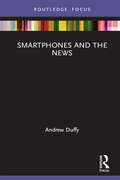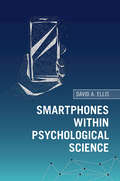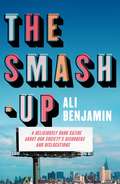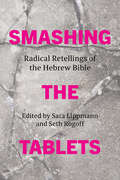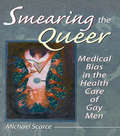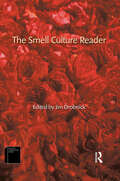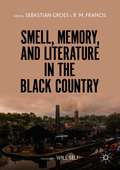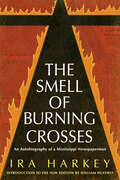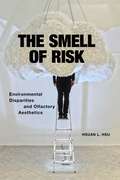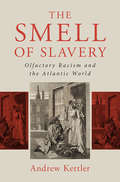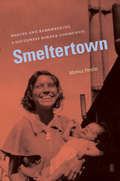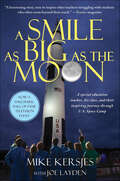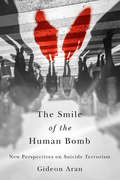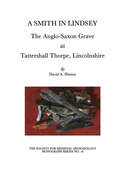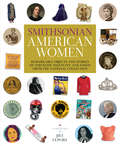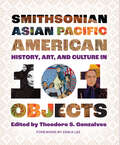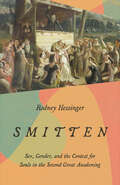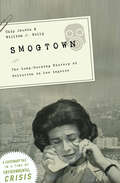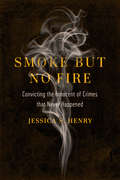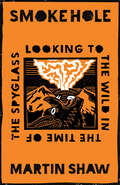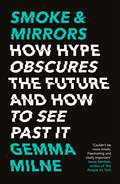- Table View
- List View
Smartphones and the News (Disruptions)
by Andrew DuffyThis book reviews recent studies into smartphones and the news, and argues that the greatest impact on news of the smartphone as a dominant technological artefact is to shift it away from an authoritative, fixed ‘first draft of history’ to become a fluid, flexible stream of information from which each individual constructs their own meaning. The news has taken on a new life, fragmented by five billion smartphones, disrupting not just an industry but also the significance of the news in societies worldwide. This book considers how the smartphone has changed the production of journalism through contributions from the general public, the dominance of visual over textual media, the shift towards brevity, the challenges of verification, and the possibilities offered by the multi-skilled mobile journalist, or MoJo. The book looks at the manner in which news is promoted and distributed via smartphones, specifically its place on social media. Finally, it considers how news-on-smartphones fits into consumers’ lives, and how their use of the smartphone to access news is impacting back on its production. This is an insightful research text for journalism students and scholars with an interest in digital journalism, new media, and the intersection between technology and communication.
Smartphones within Psychological Science
by David A. EllisPsychologists can now quantify behaviours beyond the laboratory using a mass-adopted, unified system that is primed for data capture a.k.a. smartphones. This is the first book to bring together related areas of smartphone research and point towards how psychology can benefit and engage with these developments in the future. It critically considers how smartphones and related digital devices help answer and generate new research questions for psychological science. The book then guides readers through how smartphones are being used within psychology and social science more broadly. Drawing from examples of both good and bad practice within current research, a new perspective is brought to major themes and debates across behavioural science. In the digital age, smartphones and associated devices will be able to accomplish much more in the near future. Psychology has a key role to play when it comes to balancing this monumental potential with carefully considered research.
The Smash-Up: a delicious satire from a breakout voice in literary fiction
by Ali BenjaminAN OF-THE-MOMENT NOVEL FOR READERS OF FLEISHMAN IS IN TROUBLE'Timely, risky and dazzling' Polly Clark, author of Tiger'Sharply funny, perceptive, and surprising at every turn, The Smash-Up is a story that's acid-etched and full of heart, intimate, and relevant' Amy Bloom, New York Times bestselling author of White Houses and Away'Every woman should read this book. Every woman, every feminist, every activist' Jane Harris, author of Orange Prize shortlisted The ObservationsAfter years spent in the city, working with his business partner Randy on Bränd media, Ethan finds himself in the quiet, closed-off town of Starkfield. His wife Zenobia is perpetually distracted by the swirling #MeToo politics, the Kavanaugh hearings, and her duties to the feminist activism group she formed: All Them Witches. Ethan finds himself caught between their regular meetings at his home and the battle to get his livewire daughter Alex to sleep.But the new, stilted rhythm of his life is interrupted when he receives a panicked message. Accusations. Against Randy. A slew of them. And Ethan is abruptly forced to question everything: his past, his future, his marriage, and what he values most.Unrelenting in its satire, The Smash-up jolts you into the twisted psyche of successful brand advertising, where historic exploitation is only ever a panicked phone-call away. With magnetic energy and doses of comic wit, Benjamin creates a world of social media algorithms, extreme polarization, the collapsing of identity into tweet-sized spaces, and the spectre of violence that can be found even in the quietest places.
Smashed: Story of a Drunken Girlhood
by Koren ZailckasThe day Koren turned fourteen she emerged from her friend's kitchen clutching a bottle of Southern Comfort. At fifteen she and Natalie sneaked out one summer night, then next morning had to piece back together forgotten fragments of drink, men and misplaced clothes. At sixteen she was carried through the hospital doors unconscious. And so it began. . . Koren was a sweet and normal teenager, from a stable home and loving parents, yet throughout her teens and twenties she regularly drank herself to the point of oblivion. This is the shocking but utterly recognisable story of a girl who used alcohol to help herself grow up. It began by making her feel better and making life seem less scary. It helped her know who she was, how she felt. Over time, though, she found herself almost unable to meet anyone new or embark on any social occasion at college and, later, in work, without being drunk. Finally, Koren's experimentation descended into a chaotic, dangerous dependency, until, one day, she decided she needed help. Smashed is a beautifully written book and a brutally honest account of just how easy it is to surrender your life to binge drinking. Sometimes funny, sometimes terrifying, it is unfailingly sympathetic. Told in a voice that compels but never preaches, this is a book that needed to be written and demands to be read.
Smashing the Stereotypes: What Does It Mean to Be Gay, Lesbian, Bisexual, or Transgender? (The Gallup's Guide to Modern Gay, Lesbia)
by Jaime A. Seba"That's so gay!" Most people have heard that before, but what does it really mean? Words have power and must be used cautiously. Accepting someone who is lesbian, gay, bisexual, or transgender (LGBT) begins with first understanding what each of those identities means. Consider common stereotypes of the LGBT community, explore where they come from and what they mean, and decide if they are actually valid. How can individuals do their part to reduce hurtful stereotypes and gain a better perspective on diverse people? Find out about informational resources that are available and how young people are taking action in their communities.
Smashing the Tablets: Radical Retellings of the Hebrew Bible (Excelsior Editions)
by Sara Lippmann Seth RogoffProvocative new readings of biblical texts by major contemporary Jewish writers.Lot's daughters rebel against their predatory father, Jacob wrestles an angel in a queer underground nightclub, Job arrives in the form of an avaricious former sorority girl-Smashing the Tablets presents a collection of provocative new readings of biblical texts by major contemporary Jewish writers. Behind this groundbreaking collection is the idea that foundational texts must be read anew or they become tools of conservatism and reaction. To achieve fresh readings, it is often necessary to step outside traditional modes of analysis, whether academic or theological, and to violate the conventions of storytelling and interpretation. By challenging dominant readings and identifying underrepresented characters and moments that have been "written out" of the biblical conversation, the essays, stories, and poems in this collection rupture assumptions, unsettle the reader, and give voice to the voiceless. The Bible in this collection is bent, recontextualized, queered, inverted, and smashed to pieces. Smashing the Tablets is one of the most significant Jewish literary collections in decades, a groundbreaking must-read for Jews and others interested not only in the Bible but also in identity, faith, and power.
Smearing the Queer: Medical Bias in the Health Care of Gay Men
by Michael ScarceDiscover how gay men’s health care can be improved!Smearing the Queer: Medical Bias in the Health Care of Gay Men explores how social prejudices embedded in scientific research and practice often act as a detriment to gay men’s health. This book provides an agenda for addressing heterosexism in the health sciences and in medical care while broadening approaches to gay male wellness beyond the limited scope of HIV infection. This groundbreaking book explore a number of neglected concerns affecting the sexual health of gay men , calling for the recognition of their scientific, political, and cultural significance. In Smearing the Queer, gay men, HIV prevention workers, health care providers, mental health professionals, policymakers, researchers, and instructors in related fields will appreciate the in-depth examination of such issues as: research and development on rectal microbicides why many gay men should be receiving periodic anal Pap smears to screen for anorectal cancer an in-depth critique of the problematic diagnosis of “Gay Bowel Syndrome” gay men’s use of the Reality Female Condom for anal sex Viagara’s impact on gay men’s sexual cultures, erectile dysfunction, and recreational drug use a broad-based advocacy agenda for improving relations between gay men and the health sciences the politics surrounding gay men’s restricted access to new and prospective safer sex technologies Smearing the Queer challenges heterosexist bias within the health care delivery and health sciences research and calls for the development of public policy initiatives that address gay men’s wellness in more sophisticated and complex ways. This is the only publication that provides in-depth social, cultural, and political analysis of the topics of Gay Bowel Syndrome, gay men’s use of the female condom, rectal microbicides, and anal Pap smears while examining the social forces that direct scientific research under the guise of objectivity.
The Smell Culture Reader (Sensory Formations)
by Jim DrobnickSmell is fundamental to experience but mired in paradox. Stigmatized as animalistic, it nonetheless feeds a vast fragrance and marketing industry. Considered ephemeral, scents have survived throughout the ages in a number of religious practices. The Smell Culture Reader provides a much-needed overview of what is arguably the most elusive sense. From hygiene to aromatherapy, the fetid to the fragrant, smells are shown to be much more than just an adornment or a nuisance. Addressing this engaging sense in redolent detail, The Smell Culture Reader demonstrates how essential smell is to sexuality, social status, personal identity, and cultural tradition.
Smell, Memory, and Literature in the Black Country
by Sebastian Groes R. M. FrancisFrom Banks’s brewery’s yeasty stink to groaty pudding to spicy curry, Sebastian Groes and R. M. Francis have assembled a new literary history of the smells and (childhood) memories that belong to the Black Country. This often overlooked region of the United Kingdom at the frontlines of post-industrial upheaval is a veritable treasure trove for studying the relationship between olfaction and place-specific memory. Smell, Memory, and Literature in the Black Country is an interdisciplinary exploration of the relationship between smell and memory in which the contributions consider both personal and communal memory. Drawing on psychology, neuroscience, memory studies, literary studies and philosophy, the critical essays reconsider psychogeography through cutting-edge sensory and philosophical engagements with physical space, smell, language and human behaviour. The creative contributions from writers including Liz Berry, Narinder Dhami, Anthony Cartwright, and Kerry Hadley-Pryce meditate on the senses, place, and identity. Not only does this book illustrate the rich cultural heritage of the Black Country, it will also appeal to those interested in place writing. The book is prefaced by Will Self.
The Smell of Burning Crosses: An Autobiography of a Mississippi Newspaperman (Civil Rights in Mississippi Series)
by Ira HarkeyJournalist Ira Harkey (1918–2006) risked it all when he advocated for James Meredith’s admission to the University of Mississippi as the first African American student in 1962.Preceded by a legal battle that went all the way to the Supreme Court and violent, deadly rioting, Meredith’s admission constituted a pivotal moment in civil rights history. At the time, Harkey was editor of the Chronicle in Pascagoula, Mississippi, where he published pieces in support of Meredith and the integration of Ole Miss. In 1963, Harkey won the Pulitzer Prize for editorial writing after firmly articulating his advocacy of change. Originally published in 1967, this book is Harkey’s memoir of the crisis and what it was like to be a white integrationist editor in fiercely segregationist Mississippi. He recounts conversations with University of Mississippi officials and the Ku Klux Klan’s attempts to intimidate him and muzzle his work. The memoir’s title refers to a burning cross set on the lawn of his home, which occurred in addition to the shot fired at his office. Reprinted for the fifth time, this book features a new introduction by historian William Hustwit.
The Smell of Risk: Environmental Disparities and Olfactory Aesthetics
by Hsuan L. HsuA timely exploration of how odor seeps into structural inequality Our sense of smell is a uniquely visceral—and personal—form of experience. As Hsuan L. Hsu points out, smell has long been spurned by Western aesthetics as a lesser sense for its qualities of subjectivity, volatility, and materiality. But it is these very qualities that make olfaction a vital tool for sensing and staging environmental risk and inequality. Unlike the other senses, smell extends across space and reaches into our bodies. Hsu traces how writers, artists, and activists have deployed these embodied, biochemical qualities of smell in their efforts to critique and reshape modernity’s olfactory disparities.The Smell of Risk outlines the many ways that our differentiated atmospheres unevenly distribute environmental risk. Reading everything from nineteenth-century detective fiction and naturalist novels to contemporary performance art and memoir, Hsu takes up modernity’s differentiated atmospheres as a subject worth sniffing out. From the industrial revolution to current-day environmental crises, Hsu uses ecocriticism, geography, and critical race studies to, for example, explore Latinx communities exposed to freeway exhaust and pesticides, Asian diasporic artists’ response to racialized discourse about Asiatic odors, and the devastation settler colonialism has reaped on Indigenous smellscapes. In each instance, Hsu demonstrates the violence that air maintenance, control, and conditioning enacts on the poor and the marginalized. From nineteenth-century miasma theory theory to the synthetic chemicals that pervade twenty-first century air, Hsu takes smell at face value to offer an evocative retelling of urbanization, public health, and environmental violence.
The Smell of Slavery: Olfactory Racism and the Atlantic World
by Andrew KettlerIn the Atlantic World, different groups were aromatically classified in opposition to other ethnic, gendered, and class assemblies due to an economic necessity that needed certain bodies to be defined as excremental, which culminated in the creation of a progressive tautology that linked Africa and waste through a conceptual hendiadys born of capitalist licentiousness. The African subject was defined as a scented object, appropriated as filthy to create levels of ownership through discourse that marked African peoples as unable to access spaces of Western modernity. Embodied cultural knowledge was potent enough to alter the biological function of the five senses to create a European olfactory consciousness made to sense the African other as foul. Fascinating, informative, and deeply researched, The Smell of Slavery exposes that concerns with pungency within the Western self were emitted outward upon the freshly dug outhouse of the mass slave grave called the Atlantic World.
Smeltertown
by Monica PeralesCompany town. Blighted community. Beloved home. Nestled on the banks of the Rio Grande, at the heart of a railroad, mining, and smelting empire, Smeltertown--La Esmelda, as its residents called it--was home to generations of ethnic Mexicans who labored at the American Smelting and Refining Company in El Paso, Texas. Using newspapers, personal archives, photographs, employee records, parish newsletters, and interviews with former residents, including her own relatives, Monica Perales unearths the history of this forgotten community. Spanning almost a century,Smeltertowntraces the birth, growth, and ultimate demise of a working class community in the largest U. S. city on the Mexican border and places ethnic Mexicans at the center of transnational capitalism and the making of the urban West. Perales shows that Smeltertown was composed of multiple real and imagined social worlds created by the company, the church, the schools, and the residents themselves. Within these dynamic social worlds, residents forged permanence and meaning in the shadow of the smelter's giant smokestacks. Smeltertownprovides insight into how people and places invent and reinvent themselves and illuminates a vibrant community grappling with its own sense of itself and its place in history and collective memory.
A Smile as Big as the Moon: A Special Education Teacher, His Class, and Their Inspiring Journey Through U.S. Space Camp
by Mike Kersjes Joe LaydenThe inspiring true story of how one special education teacher got his class to Space Camp—now a Hallmark Hall of Fame television event.“A heartening story, sure to inspire other teachers struggling with students who often seem beyond their reach.” —Teacher magazineMike Kersjes always believed that his students could do anything—even attend the prestigious Space Camp in Huntsville, Alabama, where some of America’s best and brightest high school students compete in a variety of activities similar to those experienced by NASA astronauts training for shuttle missions. The challenge was convincing everyone else that the kids in his special education class, with disabilities including Tourette’s syndrome, Down’s Syndrome, dyslexia, eating disorders, and a variety of emotional problems, would benefit from the experience and succeed. With remarkable persistence, Kersjes broke down one barrier after another, from his own principal’s office to the inner sanctum of NASA, until Space Camp finally opened its doors. After nine months of rigorous preparation, Kersjes’s class arrived at Space Camp, where they turned in a performance beyond everyone’s expectations.“A testament to how perseverance can get results and how children can perform surprising feats in a system that doesn’t always work to help children.” —Pittsburgh Post-Gazette“Kersjes’s refreshing, heart-warming account proves that faith and vision can yield great things.” —Publishers Weekly
The Smile of the Human Bomb: New Perspectives on Suicide Terrorism
by Gideon AranIn 2017, nearly six thousand people were killed in suicide attacks across the world.In The Smile of the Human Bomb, Gideon Aran dissects the moral logic of the suicide terrorism that led to those deaths. The book is a firsthand examination of the bomb site at the moment of the explosion, during the first few minutes after the explosion, and in the last moments before the explosion. Aran uncovers the suicide bomber’s final preparations before embarking on the suicide mission: the border crossing, the journey toward the designated target, penetration into the site, and the behavior of both sides within it. The book sheds light on the truth of the human bomb.Aran’s gritty and often disturbing account is built on a foundation of participant observation with squads of pious Jewish volunteers who gather the scorched fragments of the dead after terrorist attacks; newly revealed documents, including interrogation protocols; interviews with Palestinian armed resistance members and retired Israeli counterterrorism agents; observations of failed suicide terrorists in jail; and conversations with the acquaintances of human bombs.The Smile of the Human Bomb provides new insights on the Middle East conflict, political violence, radicalism, victimhood, ritual, and death and unveils a suicide terrorism scene far different from what is conventionally pictured. In the end, Aran discovers, the suicide terrorist is an unremarkable figure, and the circumstances of his or her recruitment and operation are prosaic and often accidental. The smiling human bomb is neither larger than life nor a monster, but an actor on a human scale. And suicide terrorism is a drama in which clichés and chance events play their role.
A Smith in Lindsey: The Anglo-Saxon Grave at Tattershall Thorpe, Lincolnshire (The Society for Medieval Archaeology Monographs #16)
by David A. Hinton"Contents Include: An introduction to the grave, conservation, metallurgical and other analyses, a catalogue of organic and inorganic materials, and a discussion of dates and context."
Smithsonian American Women: Remarkable Objects and Stories of Strength, Ingenuity, and Vision from the National Collection
by Smithsonian InstitutionAn inspiring and surprising celebration of U.S. women's history told through Smithsonian artifacts illustrating women's participation in science, art, music, sports, fashion, business, religion, entertainment, military, politics, activism, and more.This book offers a unique, panoramic look at women's history in the United States through the lens of ordinary objects from, by, and for extraordinary women. Featuring more than 280 artifacts from 16 Smithsonian museums and archives, and more than 135 essays from 95 Smithsonian authors, this book tells women's history as only the Smithsonian can. Featured objects range from fine art to computer code, from First Ladies memorabilia to Black Lives Matter placards, and from Hopi pottery to a couch from the Oprah Winfrey show. There are familiar objects--such as the suffrage wagon used to advocate passage of the 19th Amendment and the Pussy Hat from the 2016 Women's March in DC--as well as lesser known pieces revealing untold stories. Portraits, photographs, paintings, political materials, signs, musical instruments, sports equipment, clothes, letters, ads, personal posessions, and other objects reveal the incredible stories of such amazing women as Phillis Wheatley, Julia Child, Sojourner Truth, Mary Cassatt, Madam C. J. Walker, Amelia Earhart, Eleanor Roosevelt, Mamie Till Mobley, Dolores Clara Fernández Huerta, Phyllis Diller, Celia Cruz, Sandra Day O'Connor, Billie Jean King, Sylvia Rivera, and so many more.Together with illuminating text, these objects elevate the importance of American women in the home, workplace, government, and beyond. Published to commemorate the centennial of the 19th Amendment granting women the right to vote, Smithsonian American Women is a deeply satisfying read and a must-have reflection on how generations of women have defined what it means to be recognized in both the nation and the world.
Smithsonian Asian Pacific American History, Art, and Culture in 101 Objects
by Theodore S. Gonzalves Lonnie G. Bunch III Erika LeeA rich and compelling introduction to the history of Asian Pacific American communities as told through 101 objects, from a fortune cookie baking mold to the debut Ms. Marvel comic featuring Kamala KhanSmithsonian Asian Pacific American History, Art, and Culture in 101 Objects invites readers to experience both well-known and untold stories through influential, controversial, and meaningful objects. Thematic chapters explore complex history and shared experiences: navigation, intersections, labor, innovation, belonging, tragedy, resistance and solidarity, community, service, memory, and joy. The book features vibrant full-color illustrations of objects that embody and engage with Asian Pacific American issues, including the immigrant experience, the importance of media representation, what history gets officially documented vs. what does not, and so much more. Those objects include: Name tag for Challenger astronaut Ellison OnizukaPhotograph of Hollywood actress Anna May WongHello Kitty bento boxStella Abrera's ballet shoes, pancaked to match her skin colorCaravan&’s Thailand: Songs for Life albumSewing kit of internment camp survivor May IshimotoNam June Paik's Electronic Superhighway: Continental U.S., Alaska, HawaiiThe Devanagari typographical font patented by Hari Govind GovilAsian Americans are the fastest growing group in the United States and include approximately 50 distinct ethnic groups, but their stories and experiences have often been sidelined or stereotyped. This spirited and beautifully illustrated book offers a vital window into the triumphs and tragedies, strength and ingenuity, and traditions and cultural identities of these communities. Smithsonian Asian Pacific American History, Art, and Culture in 101 Objects is a crucial and celebratory read.
Smitten: Sex, Gender, and the Contest for Souls in the Second Great Awakening
by Rodney HessingerIn Smitten, Rodney Hessinger examines how the Second Great Awakening disrupted gender norms across a breadth of denominations. The displacement and internal migration of Americans created ripe conditions for religious competition in the North. Hessinger argues that during this time of religious ferment, religious seekers could, in turn, play the missionary or the convert. The dynamic of religious rivalry inexorably led toward sexual and gender disruption. Contending within an increasingly democratic religious marketplace, preachers had to court converts in order to flourish. They won followers through charismatic allure and making concessions to the desires of the people. Opening their own hearts to new religious impulses, some religious visionaries offered up radical dispensations—including new visions of how God wanted them to reorder sex and gender relations in society. A wide array of churches, including Methodists, Baptists, Mormons, Shakers, Catholics, and Perfectionists, joined the fray. Religious contention and innovation ultimately produced backlash. Charges of seduction and gender trouble ignited fights within, among, and against churches. Religious opponents insisted that the newly converted were smitten with preachers, rather than choosing churches based on reason and scripture. Such criticisms coalesced into a broader pan-Protestant rejection of religious enthusiasm. Smitten reveals the sexual disruptions and subsequent domestication of religion during the Second Great Awakening.
Smogtown: The Lung-Burning History of Pollution in Los Angeles
by Chip Jacobs William J. Kelly“A zany and provocative cultural history” of LA’s infamous air pollution and the struggle to combat it from the 1940s to today (Kirkus).The smog beast wafted into downtown Los Angeles on July 26, 1943. Nobody knew what it was. Secretaries rubbed their eyes. Traffic cops seemed to disappear in the mysterious haze. Were Japanese saboteurs responsible? A reckless factory? The truth was much worse—it came from within, from Southern California’s burgeoning car-addicted, suburban lifestyle. Smogtown is the story of pollution, progress, and how an optimistic people confronted the epic struggle against airborne poisons barraging their hometowns. There are scofflaws and dirty deals aplenty, plus murders, suicides, and an ever-present paranoia about mass disaster. California based journalists Chip Jacobs and William J. Kelly highlight the bold personalities involved, the corporate-tainted science, the terrifying health costs, the attempts at cleanup, and how the smog battle helped mold the modern-day culture of Los Angeles.
Smoke but No Fire: Convicting the Innocent of Crimes that Never Happened
by Jessica S. HenryRodricus Crawford was sentenced to die for the murder of his beautiful baby boy. After years on death row, evidence confirmed what Crawford had claimed all along: he was innocent, and his son had died from an undiagnosed illness. In Smoke but No Fire, former New York City public defender Jessica S. Henry tells the heartbreaking stories of innocent people convicted of crimes that simply never occurred. A suicide is mislabeled a homicide. An accidental fire is mislabeled an arson. A false allegation of assault is invented to resolve a custody dispute. Henry exposes a deeply flawed criminal justice system that allows—even encourages—these no-crime wrongful convictions to regularly occur. This eye-opening book grapples with the chilling reality that far too many innocent people spend real years behind bars for fictional crimes.
Smoke Hole: Looking to the Wild in the Time of the Spyglass
by Martin Shaw"With potent, lyrical language and a profound knowledge of storytelling, Shaw encourages and illuminates the mythic in our own lives. He is a modern-day bard." – Madeline Miller, author of Circe and The Song of Achilles At a time when we are all confronted by not one, but many crossroads in our modern lives—identity, technology, trust, politics, and a global pandemic—celebrated mythologist and wilderness guide Martin Shaw delivers Smoke Hole: three metaphors to help us understand our world, one that is assailed by the seductive promises of social media and shadowed by a health crisis that has brought loneliness and isolation to an all-time high. Smoke Hole is a passionate call to arms and an invitation to use these stories to face the complexities of contemporary life, from fake news, parenthood, climate crises, addictive technology and more. Shaw urges us to reclaim our imagination and untangle ourselves from modern menace, letting these tales be our guide. More Praise: "I can still remember the first time I heard Martin Shaw tell a story. The tale that emerged was like a living thing, bounding around, throwing itself at us there listening. I had never heard anything like it before." – Paul Kingsnorth, Booker shortlisted author of The Wake "Martin Shaw’s work is so very beautiful. A new animal. His love of images is deep and contagious." – Coleman Barks, author of The Essential Rumi "Through feral tales and poetic exegesis, Martin Shaw makes you re-see the world, as a place of adventure, and of initiation, as perfect home, and as perfectly other. What a gift." – David Keenan, author of Xstabeth "Shaw has so much wisdom and knowledge about the old stories, it emanates from his pores." – John Densmore, The Doors
Smoke Hole: Looking to the Wild in the Time of the Spyglass
by null Martin Shaw"A modern-day bard."—Madeline Miller, author of Circe and The Song of Achilles"Shaw has so much wisdom and knowledge about the old stories, it emanates from his pores."—John Densmore, The Doors"Through feral tales and poetic exegesis, Martin Shaw makes you re-see the world, as a place of adventure and of initiation, as perfect home and as perfectly other. What a gift."—David Keenan, author of Xstabeth"I can still remember the first time I heard Martin Shaw tell a story. The tale that emerged was like a living thing, bounding around, throwing itself at us there listening. I had never heard anything like it before."—Paul Kingsnorth, Booker shortlisted author of The WakeToday, as we are confronted by not one, but many crossroads in our lives – identity, technology, love, seduction, politics – celebrated mythologist and wilderness guide Martin Shaw delivers Smoke Hole – three ancient myths that serve as metaphors for our world today. Assailed by the seductive promises of social media and shadowed by a pandemic that brought loneliness to an all-time high, Martin argues that we are losing our sense of direction, our sense of self.He invites us to use these stories to help find &‘a commons for the imagination, a place to breathe deeper, feel steadier and become acquainted with rapture.&’ Smoke Hole is a passionate call to arms and an invitation to use these stories to face the complexities of contemporary life, from fake news to parenthood, climate crises, addictive technology and more.
Smoke & Mirrors: How Hype Obscures the Future and How to See Past It
by Gemma Milne'Stop following the news until you've read Gemma Milne's persuasive analysis of the hype and bullshit that distort our understanding of emerging science. As she shows, the starting point to grasping the genuine opportunities of AI, life sciences and climate tech is a healthy dose of critical thinking'David Rowan, founding editor of WIRED UK and author of Non-Bullshit Innovation: Radical Ideas from the World's Smartest Minds'Couldn't be more timely. Fascinating and vitally important'Jamie Bartlett, author of The People Vs Tech'A much-needed blast of fresh air! Gemma Milne expertly shows us how to separate the truth from the hype surrounding the emerging techs of today, and those of the near-tomorrow'Lewis Dartnell, author of Origins: How the Earth Made Us'I loved this book! This is exactly the sort of sceptical, cut-through-the crap-but-still-excited-about-what's-emerging book around tech innovation that's sorely needed, yet is so hard to find . . . essential reading for anyone who's serious about how real-world advances might be effectively harnessed to build a better future'Dr Andrew Maynard, scientist and author of Films from the Future and Future Rising'[A] vital contribution in a world where technological progress promises so much, but too often disappoints. If, like me, you believe that advances in science and technology are our best hope for solving the grand challenges of our times, this book is the indispensable guide to avoiding the mirages and the charlatans along the way'Matt Clifford, co-founder and CEO of Entrepreneur First'A refreshingly grown-up, clear-headed look at the interaction between science, technology and the media - readable without being dumbed down, acknowledging complexities without being heavy'Tom Chivers, author of The AI Does Not Hate You'ROBOTS WILL STEAL YOUR JOB!''AI WILL REVOLUTIONISE FARMING!''GENETIC EDITING WILL CURE CANCER!'Bombastic headlines about science and technology are nothing new. To cut through the constant stream of information and misinformation on social media, or grab the attention of investors, or convince governments to take notice, strident headlines or bold claims seem necessary to give complex, nuanced information some wow factor.But hype has a dark side, too.It can mislead. It can distract. It can blinker us from seeing what is actually going on.From AI, quantum computing and brain implants, to cancer drugs, future foods and fusion energy, science and technology journalist Gemma Milne reveals hype to be responsible for fundamentally misdirecting or even derailing crucial progress.Hype can be combated and discounted, though, if you're able to see exactly where, how and why it is being deployed.This book is your guide to doing just that.
Smoke & Mirrors: How Hype Obscures the Future and How to See Past It
by Gemma Milne'Stop following the news until you've read Gemma Milne's persuasive analysis of the hype and bullshit that distort our understanding of emerging science. As she shows, the starting point to grasping the genuine opportunities of AI, life sciences and climate tech is a healthy dose of critical thinking'David Rowan, founding editor of WIRED UK and author of Non-Bullshit Innovation: Radical Ideas from the World's Smartest Minds'Couldn't be more timely. Fascinating and vitally important'Jamie Bartlett, author of The People Vs Tech'A much-needed blast of fresh air! Gemma Milne expertly shows us how to separate the truth from the hype surrounding the emerging techs of today, and those of the near-tomorrow'Lewis Dartnell, author of Origins: How the Earth Made Us'I loved this book! This is exactly the sort of sceptical, cut-through-the crap-but-still-excited-about-what's-emerging book around tech innovation that's sorely needed, yet is so hard to find . . . essential reading for anyone who's serious about how real-world advances might be effectively harnessed to build a better future'Dr Andrew Maynard, scientist and author of Films from the Future and Future Rising'[A] vital contribution in a world where technological progress promises so much, but too often disappoints. If, like me, you believe that advances in science and technology are our best hope for solving the grand challenges of our times, this book is the indispensable guide to avoiding the mirages and the charlatans along the way'Matt Clifford, co-founder and CEO of Entrepreneur First'A refreshingly grown-up, clear-headed look at the interaction between science, technology and the media - readable without being dumbed down, acknowledging complexities without being heavy'Tom Chivers, author of The AI Does Not Hate You'ROBOTS WILL STEAL YOUR JOB!''AI WILL REVOLUTIONISE FARMING!''GENETIC EDITING WILL CURE CANCER!'Bombastic headlines about science and technology are nothing new. To cut through the constant stream of information and misinformation on social media, or grab the attention of investors, or convince governments to take notice, strident headlines or bold claims seem necessary to give complex, nuanced information some wow factor.But hype has a dark side, too.It can mislead. It can distract. It can blinker us from seeing what is actually going on.From AI, quantum computing and brain implants, to cancer drugs, future foods and fusion energy, science and technology journalist Gemma Milne reveals hype to be responsible for fundamentally misdirecting or even derailing crucial progress.Hype can be combated and discounted, though, if you're able to see exactly where, how and why it is being deployed.This book is your guide to doing just that.
